[Bianculli here: All TV critics have their quirky specialties, and we here at TV WORTH WATCHING are no different. But I admit to being ignorant of, though curious about, the majority of Japanese anime programs. But one of my former college students at Rowan University, Rich Greenhalgh, is passionate about the subject, so I gave him a dare: Write a column about anime explaining what's hot, and why. He came through, and even provided links for us to become instantly anime-literate...]
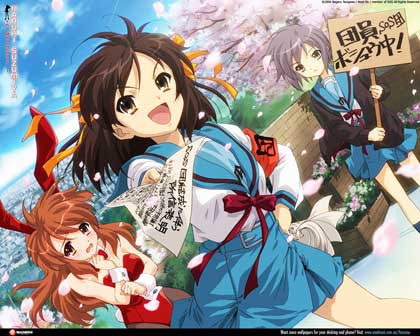 Why Doesn't American TV Offer Edible Eyebrows?
Why Doesn't American TV Offer Edible Eyebrows?
By Rich Greenhalgh
2009's Japanese Anime season was a year no one saw coming. This year had the death and rebirth of an unstoppable God and the arrival of the all-girl "Beatles" of anime. Japanese anime is a genre mostly known for giant robots, cat girls, big guns, and samurais. What stole the hearts, minds, and money of many of Japans most fervent Otakus (Japanese for "Anime Geek/ Enthusiast"): four charmingly simple high school girls with a dream.
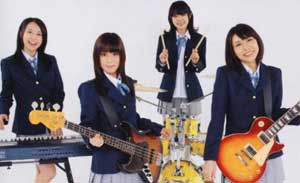
The past Spring's offering of K-On! simply followed the ingredients of the manga source material. All they needed was four female seiyuu's (Japanese voice actresses) who could also sing. Thus the female pop group "Sphere" was created specifically for the show (similar to the Monkees). Even the actresses themselves were still pretty new in anime. This show didn't have anything in its chamber but its obscenely excessive uses of 'Moe' (spoken 'Moh-Eh', short for 'Moekko' -- meaning blossoming girl) in its character design and episodic way of story telling.
What exactly is 'Moe'? It's an exaggeration on the importance of 'cuteness' in Japanese society. For example: American actress Summer Glau or TV's Kelly Ripa wearing cat ears is VERY Moe, whereas Christina Hendricks (Mad Men) or Olivia Wilde (House) is not. Others liken it to feelings of affection or devotion for a female without sexualizing them.
I have often stated that Dollhouse (on Fox) suffered a severe lack of Moe. Interestingly, Buffy the Vampire Slayer, in its first three seasons, used a lot of what is what is American Moe, even before it was properly defined. Archetypal females are often used in anime and right now the 'Moe boom' is huge.

K-On! (Keion) doesn't have gun battles, swordplay, mystery, magic, or excessive 'fan service' (scantily clad women) -- it just oozes pop music and oceans of Moe. Even the characters in the show tease each other about how insecure they are about being cute (which is like 'cute squared' in Japan). They are awkward, girly, lazy, teasing, and they're constantly eating desserts and wearing cute outfits while learning how to be a band.
Match this with a cute pop group and they became a license to print money. Both males and females got into this seemingly average show.
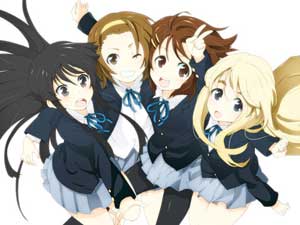
Each character has been merchandised to death on everything from guitars, apparel, figurines, giant pillows, and food products. The most popular is the practical yet shy bassist Mio Akiyama.
This show's music hit the top of Japan's Amazon music charts by the end of the first month after airing. It also broke a record for its Vol. 1 DVD, selling over 40,000 in a single day. Currently the first 3 volumes have sold over 8 million in US dollars (converted from Yen).
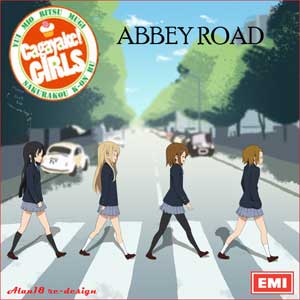
Click HERE to see the opening that started it all (Subtitled in English). The Moe characteristics will be VERY obvious.
And click HERE for a look at the real-life musical voices for K-On!, called "Sphere" (English Subbed).
How big is Moe marketing? The sales of the exact types of the musical instruments the girls play jumped and began popping up in display windows. The strangest yet? Tokai Tsukemono Corp will unleash pickled radish snacks that look like keyboardist character Tsumugi Kotobuki's (Mugi-chan) eyebrows, which are her most Moe trait.
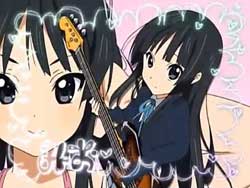
Mio, on the other hand, has been officially endorsed by the Fender guitar company for being a lefty that rocks a vintage 62 Jazz Bass. The pop group Sphere has already released a second album, and season two of K-On! has already begun production, to the acclaim of fans and merchandisers alike. In this jaded age of Paris and Brittany, maybe America needs a little Moe. They will never be as big as The Beatles musically, but in musical anime, they might as well be.
The worst disaster of 2009 ironically comes from Kadokawa Shoten (who successfully started the original Moe boom back in 2004), in the form of the long-awaited (three years!) second season to The Melancholy of Haruhi Suzumiya. Haruhi season one became an instant cult sensation (even in its dubbed English form) across the globe.

Its lead seiyuu, Aya Hirano (Japan's answer to Miley Cyrus) is iconic in Japanese culture for this role. The main focus is Haruhi Suzumiya, a girl who unconsciously changes and warps reality around her because a part of her never really 'grew up.' Haruhi's only goal is looking for aliens, time travelers, psychics, and anything strange.
Haruhi has no idea she's changing the world around her, so she is constantly guarded and observed by mysterious and magically gifted characters (created by her) that disguise themselves as students and collude in keeping her illusion of a 'normal reality' intact. Should she become bored or disillusioned with her quest, all these characters may cease to exist. They have one hope. It's a cynical classmate who can barely stand her, named Kyon, who mistakenly gives her the idea of starting a club to investigate all these strange things.
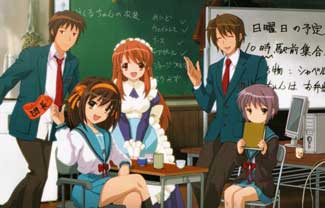 One by one these strange beings start gathering under Haruhi's nose. Haruhi is pretty, intelligent, adorable and obnoxious, with too much enthusiasm and too many dreams. Japanese girls all want to be her and all the guys want to date her -- but Haruhi could care less, because she is looking for aliens, time-travelers, and psychics! God help the world and reality if she ever learns the truth is right behind her.
One by one these strange beings start gathering under Haruhi's nose. Haruhi is pretty, intelligent, adorable and obnoxious, with too much enthusiasm and too many dreams. Japanese girls all want to be her and all the guys want to date her -- but Haruhi could care less, because she is looking for aliens, time-travelers, and psychics! God help the world and reality if she ever learns the truth is right behind her.
The anticipation for season two was as anticipated in Japan as that for the final season of The Sopranos was stateside. What could possibly ruin this omni-powerful franchise? The story arc called "Endless Eight." Imagine 75 percent of the final season of The Sopranos being the same episode, eight weeks in a row. Why? Because the characters are stuck in a 'time-loop' created by Haruhi, and their August summer keeps repeating 15,532 times). None of the characters know how to stop it and Haruhi and the world aren't aware she's doing it.
By the fourth rotation, fans were pretty annoyed. By the fifth, the voice actors were apologizing to fans. By the sixth week, fans were burning down the anime forums. By the seventh, fans had given up. On the eighth week, the studio apologized, and on the ninth week, the story ended.

The remaining new five episodes were moderately well received by whatever fans remained. What was the most anticipated, highly secretive, sure-fire event of the year turned out to be the butt of jokes that, among anime fans, will last endlessly for the next eight years! Not even David Lynch from Twin Peaks would have tried something this risky with this powerful a franchise. The actors had to voice the same episode eight times with minor differences, and the animators had to draw it eight different ways! -- same story. The ending was worse than being all a dream, or a "snow globe."
Click HERE for an Eight-Panel comparison of all eight at once.
http://www.youtube.com/watch?v=zeNfnUg7ZZE
Lost and Sopranos fans wouldn't tolerate this. The plans for season three appeared to be scrapped, but Kadokowa appears to have planned all along to make season three into a movie. Its running time is 150 minutes, which will cover "The Disappearance of Haruhi Suzumiya" arc.
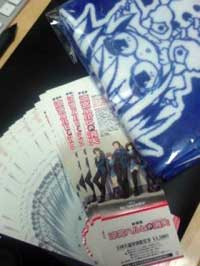
Otakus began pre-ordering tickets weeks in advance. A story from the English Otaku news site Sankaku Complex.com reports the story of one fan who proudly displayed his cache of thirty tickets (a whole row) he bought just for himself. These fans are devoted to their 'God' Haruhi. I can't imagine why someone hasn't made a live-action American version of Haruhi yet.
Click HERE for the short U.S. English-dubbed trailer for season one from Bandai Entertainment, so you can meet Haruhi for yourself. Season two will arrive in a few months.
And here's a clip of the Japanese actors doing a live stage concert as their characters. Click HERE to watch the packed stadium audience go total Fan-Crazy just to see them live. Mind you, these are 13-30+ year olds (It's subbed in English!).
Imagine if the cast of House or Lost did a live show?
Just when you thought American TV and its audience had issues, be glad you're not competing with Anime Idols and an obscene army of fickle Otakus, hell bent on worship. No one bought the hammer used in season four of Dexter, and no one knows the clothes and sneakers Dr. House is wearing. Japan's TV marketing would make Don Draper of Mad Men weep!
You can watch both these shows on YouTube by keywording their titles (adding English DUB or Subbed) or buy the season one collections at places like BestBuy.com or Amazon.com.
I could show you where to download them all for FREE... but you are not Otaku yet.
--
Rich Greenhalgh is a student at Rowan University. He shares at least one trait with the professional TV critics here at TV WORTH WATCHING, in that he's way too obsessed with, and enthusiastic about, various forms of pop culture. Please let him know if his Anime 101 summary was to your liking.